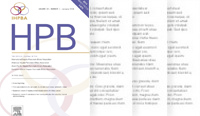International Hepato-Pancreato-Biliary Association
HPB Blog - September 2019

Focus on technical issues
This month’s issue of HPB has a real technical bent with many papers focusing on trying to answer a technical question. The range of issues covered is wide. Starting with the systematic reviews Kamarajah et al have performed a review comparing the outcomes of patients undergoing robotic vs laparoscopic distal pancreatectomy. The important point to come from this review was the lack of randomised data. The robotic approach was associated with a longer operating time but a significant reduction in the risk of conversion to open surgery. Of the other outcome metrics including complications there did not seem to be any difference. In a similar vein van Rosmalen et al performed a systematic review that compared the outcomes of patients undergoing open or minimally invasive liver resection for benign solid tumours. The outcome measures were quality of life metrics. Once again randomised data or propensity matched studies were lacking. However 42 studies containing 4061 patients met the inclusion criteria. However only 13% underwent laparoscopic resection. The analysis suggested there was a high rate of symptom resolution in those who were symptomatic however more studies were required to know whether the laparoscopic approach truly offered improvement in quality of life. From the transplant desk, Muller et al report an impressive series of 21 patients who received “futile” liver donor-recipient combinations. The normal expected graft survival for this combination is reported to be <40% at 1 year. However after treating them with hypothermic oxygenated perfusion the 1year graft survival was 86%. Borrowing techniques from transplant Navez et al report on 27 patients who underwent total hepatic exclusion for complex liver resection. Patients who had veno-veno bypass performed had reduced blood loss and post-operative respiratory complications leading to the authors recommending its use when there is likely to be prolonged HVE. Sticking with complex liver resections and learnings from transplant Shen et al describe their experience with complicated hepatic alveolar echinococcosis invading the inferior vena cava. This is well worth a read! While Wronski et al describe their experience with managing the pancreatic remnant after grade C pancreatic fistula. Sober reading indeed. Moving to the IR suite Esposito et al have performed a systematic review looking at the outcomes of the combination of portal and hepatic vein embolisation. The results were encouraging and the range of hypertrophy significant. This is an excellent paper including the technical considerations if you are contemplating using this technique. Another important paper is that by Urbonas and colleagues who demonstrate MWA ablation is subject to a heat sink effect and caution needs to be applied for CRCLM close to major vessels. Sticking with CRCLM Ruzzenente et al demonstrate that response to neoadjuvant chemotherapy needs to be a multimodal assessment including tumour burden score both at presentation and the delta following chemotherapy. In patients with a low tumour burden score genetic assessment of tumour should also be applied.
In terms of complications Ito et al have demonstrated PHLF to be associated with reduced long term survival for patients with CRCLM, while Huang et al show malnutrition is associated with increased post-operative complications for patients undergoing resection for HCC. Bagante et al provide a method to benchmark a units complication rates against a big international dataset. Included in the paper is a worldwide validation cohort proving its worth. This may help units assess their performance in a risk adjusted manner.
Moving onto the pancreas there is a very thought provoking paper from Lee et al. Using a large dataset of clinically staged early pancreatic cancer the authors observed that neoadjuvant chemotherapy followed by surgery was associated with a reduction in upstaging and a survival advantage as compared to a traditional surgery + adjuvant chemotherapy approach. When considering borderline pancreatic cancer Kato et al suggest using the IAP criteria which include assessment of biological aggressiveness as comparted to the NCCN guidelines as the survival curves are more likely to be separated. Finally a large series of patients with hypertriglyceridaemia associated pancreatitis are presented by Zhang et al. This provides some fascinating insights into this severe form of acute pancreatitis.
Saxon Connor
Corporate Partners
If you are interested in becoming a Corporate Partner of the IHBPA please contact industry@ihpba.org
Find out more


